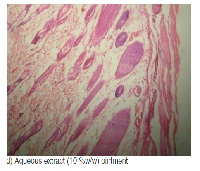Evaluation of wound healing potential of Jatropha gossypifolia Linn. root extracts in normal and diabetic rats
Keywords:
Excision, incision, diabetic wound, hydroxyprolineAbstract
Jatropha gossypifolia Linn. is used in Indian folk medicine for treatment of cuts and wounds. Root extract is used to promote wound and fracture healing in animals. Present study was conducted to assess wound healing potential of ointments prepared using successive extracts of roots of the plant. Incision and excision wounds were inflicted upon normal and nicotinamide streptozotocin-induced diabetic rats, respectively. Animals were treated topically with ointments containing 5% and 10% w/w petroleum ether (60-80°C), chloroform, methanol and aqueous extracts. Percentage of wound contraction, epithelization time, tensile strength, hydroxyproline content and histopathology of regenerated skin were evaluated in comparison with reference nitrofurazone (0.2% w/w) ointment. Breaking strength of incision wounds in 5% and 10% w/w methanolic extract ointment treated groups significantly (P < 0.01) increased to 695.75 and 759.50 g, respectively, as compared to standard (653.92g). In diabetic rats, apart from methanol extract, aqueous extract also exhibited extraordinary wound healing capacity and elevated hydroxyproline content. Measurement of hydroxyproline, the product of collagen breakdown, is used as an index of collagen turnover. Elevated hydroxyproline content in diabetic animals signify the increased collagen deposition in wounded tissues as evident from histopathology. There is also an increase in the tensile strength of incision wounds in rats. The experimental study confirms the folk medicinal use of the plant.
References
. Biswas, T.K., Maitry, L.N., Mukherjee, B., Wound healing potential of Pterocarpus santalinus Linn: a pharmacological evaluation. Int. J. Low Extrem. Wounds, 2004, 3, 143-150.
. Mukherjee, P.K., Mukherjee, K., Pal, M., Saha, B.P., Wound healing potential of Nelumbo nucifera (Nymphaceae) rhizome extract. Phytomedicine, 2000, 7, 66-73.
. Biswas, T.K., Mukherjee, B., Plant medicines of Indian origin for wound healing: a review. Int. J. Low Extrem. Wounds, 2003, 2(1), 25-39.
. Purna, S.K., Babu, M., Collagen based dressings - a review. Burns, 2000, 26, 54-62.
. Sastri, B.N. (1962). The Wealth of India, Raw Materials, CSIR, New Delhi.
. Kirtikar, K.R., Basu, B.D. (2002). Indian Medicinal Plants, Popular Prakashan, Dehradun.
. Kumar, B., Vijayakumar, M., Govindarajan, R., Pushpangadan, P., Ethnopharmacological approaches to wound healing – Exploring medicinal plants of India. J. Ethnopharmacol., 2007, 114, 103-113.
. Jaiswal, S., Singh, S.V., Singh, B., Singh, H.N., Plants used for tissue healing of animals. Natural Product Radiance, 2004, 3(4), 284-292.
. Sharma, S.K., Singh, H., A review on pharmacological significance of genus Jatropha (Euphorbiaceae). Chin. J. Integr. Med., 2012, 18(11), 868-880.
. Shukla, A., Rasik, A.M., Jain, G.K., Shankar, R., Kulshrestha, D.K., & Dhawan, B.N., In vitro and in vivo wound healing activity of asiaticocsde isolated from Centella asiatica. J. Ethnopharmacol., 1999, 65, 1-11.
. Silambujanaki, P., Chandra, B.T., Kumar, A.K., & Chitra, V., Wound healing activity of Glycosmis arborea leaf extract in rats. J. Ethnopharmacol., 2011, 134, 198-201.
. Akkola, E.K., Acikara, O.B., Suntar, I., Citoglu, G.S., Keles, H., Ergene, B., Enhancement of wound healing by topical application of Scorzonera species: Determination of the constituents by HPLC with new validated reverse phase method. J. Ethnopharmacol., 2011, 137, 1018-1027.
. Lee, K.H., Studies on the mechanism of action of salicylates. Effect of vitamin A on wound healing retardation of aspirin. J. Pharm. Sci., 1968, 57(7), 1238-1240.
. Shanbhag, T.V., Sharma, C., Adiga, S., Bairy, L.K., Shenoy, S., Shenoy, G., Wound healing activity of alcoholic extract of Kaempferia galanga in Wistar rats. Indian J. Physiol. Pharmacol., 2006, 50(4), 384–390.
. Thakare, V.M., Chaudhari, R.Y., Patil, V.R., Wound healing evaluation of some herbal formulations containing Curcuma longa and Cynodon dactylon extract. International Journal of Phytomedicine, 2011, 3, 325-332.
. Woessner, J.F., Jr., The determination of hydroxyproline in tissue and protein samples containing small proportions of this imino acid. Arch. Biochem. Biophys., 1961, 93, 440-447.
. Lerman, O.Z., Galiano, R.D., Armour, M., Levine, J.P., Gurtner, G.C., Cellular dysfunction in the diabetic fibroblasts: impairment in migration, vascular endothelial growth factor production, response to hypoxia. American Journal of Pathology, 2003, 162, 303–312.
. Sivan-Loukianova, E., Awad, O.A., Stepanovic, V., Bickenbach, J., & Schatteman, G.C., CD34+ blood cells accelerate vascularization and healing of diabetic mouse skin wounds, J. Vasc. Res., 2003, 40, 368–377.
. Hirsch, T., Spielmann, M., Zuhaili, B., Koehler, T., Fossum, M., Steinau, H., Yao, F., Steinstraesser, L., Onderdonk, A.B., Eriksson, E., Enhanced susceptibility to infections in a diabetic wound healing model. BMC Surg., 2008, 8, 5–12.
. Agarwal, P.K., Singh, A., Gaurav, K., Goel, S., Khanna, H.D., Goel, R.K., Evaluation of wound healing activity of extracts of plantain banana (Musa sapientum var. paradisiaca) in rats. Indian J. Exp. Biol., 2009, 47, 32-40.



